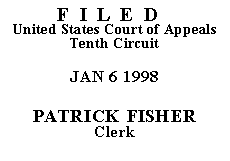

| UNITED STATES OF AMERICA, | No. 97-7082
(D.C. No. 96-CV-650-S) |
Petitioner's sole claim on this collateral appeal is that the jury instructions relating to the § 924(c) count were inadequate in light of Bailey, thus mandating the reversal of that conviction. At trial, the jury was instructed:
In order to establish the offense of using or carrying a firearm during and in relation to any crime of violence . . ., each of the following essential elements must be proven beyond a reasonable doubt by the evidence:
1. That the defendant used or carried a firearm; and
2. That the defendant did so during and in relation to a crime of violence.
For purposes of this law, the using or carrying of a firearm element is satisfied when the defendant has ready access to the firearm and the firearm is an integral part of his criminal undertaking and its availability increased the likelihood that the criminal undertaking would succeed.
R. Vol I, Doc. 8, at 2. Under Bailey, this instruction is incorrect as to the definition of "use."(1) See United States v. Holland, 116 F.3d 1353, 1356 (10th Cir. 1997).
However, petitioner does not and cannot contend that the instructions as to "carry" were improper. See United States v. Arias-Santos, No. 96-1490, 1997 WL 452254, at *2 & n.2 (10th Cir. Aug. 8, 1997) (concluding that a similar jury instruction was incorrect only as to the definition of "use"). Thus, we are confronted with a situation in which petitioner was convicted under an improper "use" instruction and a proper "carry" instruction. This court was confronted with a similar dilemma in Holland. See 116 F.3d at 1357-58. In Holland, we held that "[t]he fact that the evidence was sufficient to support a conviction on the legally valid ground does not eliminate [the possibility that he was convicted for non-criminal conduct] or the resulting prejudice unless we can be assured the jury did in fact rely on the valid ground, or unless, in convicting . . ., the jury necessarily made the findings required to support a conviction on the valid ground." Id. at 1358.
At petitioner's trial, the government's argument that defendant violated § 924(c) was based on:
1) testimony from co-conspirators that they discussed the need to use a gun before the robbery, 2) testimony from a co-conspirator that he saw the robber put the gun in his coat before the robbery, 3) testimony from witnesses that the robber kept his hand inside his coat during the robbery as if he were hiding a gun, and 4) testimony from a co-conspirator that the robber came to his house after the incident and bragged about wielding a gun during the robbery and how it made him feel powerful.
Emberson, 1994 WL 131729, at *1. For the jury to have found petitioner guilty of the § 924(c) violation, they necessarily must have found that he had the gun in his coat pocket during the course of the robbery.(2) Although this conduct may be insufficient to satisfy the "active employment" requirement for "use," it is clearly sufficient to satisfy the requirements for "carry." See Bailey, 116 S. Ct. at 507 ("a firearm can be carried without being used, e.g., when an offender keeps a gun hidden in his clothing throughout a drug transaction."); United States v. Montes-Fierro, No. 96-2002, 1997 WL 174110, at *3 (10th Cir. Apr. 10, 1997) ("There is no doubt that carrying a weapon in one's clothing satisfies the 'carrying' prong."); Broadway v. United States, 104 F.3d 901, 905 (7th Cir. 1997) ("if keeping a gun in your pants pocket does not constitute 'carrying' a gun, we cannot imagine what would.") (quotations omitted).
Thus, because "[t]hese findings were made under proper [carry] instructions, unaffected by Bailey, and supported by sufficient evidence [and] [b]ecause the necessary jury findings together satisfy all the requirements needed to support a conviction [under § 924(c)]," Holland, 116 F.3d at 1359, petitioner has failed to show that he was convicted for conduct that is not made criminal by the law. We therefore decline to grant petitioner relief under § 2255.
AFFIRM.
The mandate shall issue forthwith.
ENTERED FOR THE COURT
Carlos F. Lucero
Circuit Judge
*.The case is unanimously ordered submitted without oral argument pursuant to Fed. R. App. P. 34(a) and 10th Cir. R. 34.1.9. This order and judgment is not binding precedent, except under the doctrines of law of the case, res judicata, and collateral estoppel. The court generally disfavors the citation of orders and judgments; nevertheless, an order and judgment may be cited under the terms and conditions of 10th Cir. R. 36.3.
1.In Bailey, the Supreme Court held that "use" in § 924(c)(1) requires "evidence sufficient to show an active employment of the firearm by the defendant, a use that makes the firearm an operative factor in relation to the predicate offense." 116 S. Ct. at 505. The Court explained that "'use' certainly includes brandishing, displaying, bartering, striking with, and most obviously, firing or attempting to fire, a firearm." Id. at 508.
2.The jury's finding of guilt, given the instructions, precludes petitioner's argument that the jury could have believed testimony that the gun was left in the car.